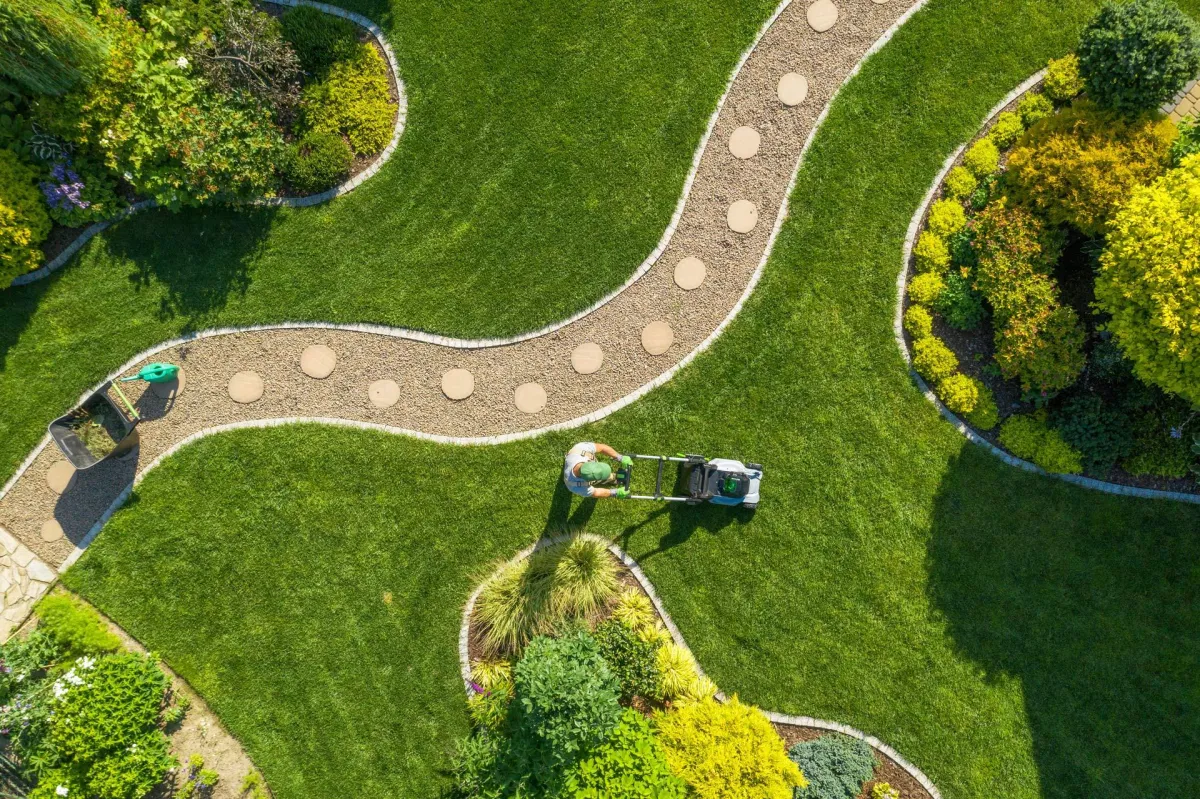Serving Orange County
Blog

7 Landscape Design Mistakes That Can Hurt Your Curb Appeal
First impressions matter, especially when it comes to your home's exterior. Your front yard is the first thing visitors and potential buyers see, making it a crucial element of your property's overall appeal. A well-designed landscape can significantly boost your home's value and create a welcoming atmosphere, while design missteps can detract from even the most beautiful house.
The most common landscape design mistakes that hurt curb appeal include poor plant selection, lack of planning, improper scaling, neglecting seasonal interest, insufficient lighting, poor maintenance, and disregarding your home's architectural style. Avoiding these mistakes can make a dramatic difference in how your property looks and feels.
Understanding these common pitfalls can help you create an outdoor space that enhances your home's appearance rather than detracting from it. Whether you're planning a new garden or updating an existing landscape, this guide will help you identify and avoid the most damaging mistakes that homeowners make when designing their front yards.
Mistake #1: Poor Plant Selection and Placement
Choosing Plants That Don't Thrive in Your Climate
One of the biggest mistakes homeowners make is selecting plants that aren't suited to local conditions. In Orange County, with its Mediterranean climate, this often means:
Installing water-hungry plants that struggle during drought periods
Choosing varieties that can't handle coastal conditions or inland heat
Planting species that require more maintenance than you can provide
For successful landscaping, focus on native plants and drought-tolerant options that naturally thrive in Southern California. These plants not only look better longer but also require less water and care.
Improper Plant Spacing
Another common mistake is improper spacing between plants:
Planting too close together: Creates overcrowding as plants mature
Spacing too far apart: Makes the landscape look sparse and incomplete
Not accounting for mature size: Leads to overgrown walkways and blocked windows
When planning your garden, always consider the mature size of each plant. What looks appropriately spaced at planting can become a crowded mess within a few years without proper planning.
Forgetting About Scale and Proportion
Scale errors can make your landscape look awkward:
Tiny plants lost against a large facade
Massive trees that overwhelm a small property
Single plants that look random and disconnected
Create visual harmony by using plants that match your home's scale. Larger homes need larger anchor plants, while smaller homes look best with appropriately sized vegetation arranged in thoughtful groupings.
Mistake #2: Lack of Cohesive Design Plan
Random Plant Selection Without a Theme
Many homeowners add plants impulsively, resulting in a disconnected look:
Too many different plant types creating visual chaos
Clashing colors that don't work together
Mixing incompatible garden styles (formal with wildflower, for example)
Develop a consistent theme for your landscape that complements your home. Mediterranean, contemporary, cottage garden, or native California styles all work well in Orange County. Choose one direction and stick with it for a polished look.
Ignoring Your Home's Architectural Style
Your landscape should enhance your home's architecture, not fight against it:
Contemporary homes pair well with clean lines and structural plants
Traditional homes benefit from more classic, symmetrical designs
Spanish or Mediterranean-style homes look best with appropriate regional plants
Make landscaping decisions that complement your home's character. The right plantings and hardscape can highlight architectural features and create a seamless indoor-outdoor connection.
Neglecting to Create Focal Points
Without focal points, the eye wanders without purpose:
Flat landscapes with no visual hierarchy
Lack of standout features to draw attention
Too many competing elements creating confusion
Include at least one strong focal point in your front yard, such as a specimen tree, decorative boulder, water feature, or architectural plant. This gives the eye a place to rest and organizes the rest of the design around it.
Mistake #3: Improper Scaling and Balance
Overwhelming Small Spaces
In smaller yards, less is often more:
Too many plant varieties making the space feel cluttered
Oversized features that dominate limited square footage
Insufficient open space creating a cramped feeling
For smaller properties, choose a limited palette of plants and materials. Emphasize quality over quantity, and include adequate breathing room between elements.
Undersizing Features in Large Spaces
Conversely, features that are too small get lost in larger landscapes:
Tiny plant groupings that disappear in expansive yards
Narrow walkways that look out of proportion
Undersized garden beds that appear insignificant
In larger yards, create bold, substantial elements that stand up to the scale of the space. Consider larger plant groupings, wider paths, and more dramatic focal points.
Imbalanced Visual Weight
Poor balance creates an unsettled feeling:
All tall plants on one side with low plants on the other
Heavy visual elements concentrated in one area
Lack of rhythm and repetition throughout the design
Distribute visual weight evenly throughout your landscape using the principles of balance and repetition. This doesn't mean perfect symmetry, but rather a harmonious distribution of colors, heights, and textures.
Mistake #4: Neglecting Seasonal Interest
Focusing Only on Spring or Summer Appeal
Many landscapes look great for one season but lackluster the rest of the year:
Gardens that bloom beautifully in spring but offer nothing in fall and winter
Summer-focused plantings that die back completely in cooler months
Lack of structural elements that provide interest year-round
Plan for year-round appeal by including plants with different seasonal highlights. Mix flowering perennials with evergreens, ornamental grasses, and trees with interesting bark or structure.
Overlooking Non-Plant Elements
Plants shouldn't be your landscape's only source of interest:
Lack of hardscaping elements that provide structure
Missing decorative features that add personality
No architectural elements that create winter interest
Incorporate durable hardscape features like decorative stone, garden art, or built elements that look good regardless of season. These provide structure when plants are dormant or between bloom cycles.
Forgetting About Fall and Winter Views
Your landscape is visible year-round, even in "off" seasons:
No evergreen foundation plantings to provide winter structure
Lack of fall color consideration
All plants that die back completely in winter
Include some plants specifically chosen for fall color and winter interest. Ornamental grasses, trees with interesting bark, and plants with persistent berries or seed heads provide appeal even in dormant seasons.
Mistake #5: Inadequate Lighting
Dark Entryways and Pathways
Poor lighting creates safety issues and misses opportunities to highlight your landscape:
Unlit walkways creating trip hazards
Dark front doors that feel unwelcoming
Shadowy areas that create security concerns
Install adequate path lighting to guide visitors safely to your door. Well-lit entryways not only enhance safety but also create a warm, inviting approach to your home.
Missing Accent Lighting
Lighting can dramatically enhance your landscape after dark:
Failure to highlight architectural features or specimen plants
No uplighting on trees or structural elements
Lack of ambient lighting for evening enjoyment
Use strategic accent lighting to showcase special landscape features and create evening ambiance. Solar options make this easier and more affordable than ever before.
Harsh or Poorly Placed Fixtures
Not all lighting is good lighting:
Overly bright fixtures that create glare
Visible light sources that distract from the illuminated features
Improper placement that creates harsh shadows
Choose fixtures that blend into the landscape during the day and provide appropriate light levels at night. Focus on lighting effects rather than the fixtures themselves.
Mistake #6: Poor Maintenance Practices
Improper Pruning Techniques
Bad pruning is immediately noticeable and damages plants:
Shearing everything into balls or boxes regardless of natural form
Topping trees, creating weak regrowth and ugly shapes
Neglecting dead or diseased branches
Learn proper pruning techniques for each plant type in your garden. Some benefit from regular shaping while others look best when allowed to grow in their natural form with minimal intervention.
Neglecting Regular Upkeep
Even the best designs fail without proper care:
Overgrown plants blocking windows or pathways
Untended weeds competing with desirable plants
Dead flowers and foliage creating a messy appearance
Develop a regular maintenance schedule or hire professional landscape maintenance services. Consistent care keeps your landscape looking its best and prevents small issues from becoming big problems.
Inefficient Irrigation Practices
Water issues quickly affect plant health and appearance:
Overhead sprinklers wasting water and promoting disease
Inadequate water reaching root zones
Overwatering that promotes shallow roots
Install efficient drip irrigation systems that deliver water directly to plant roots. Proper watering keeps plants healthy while conserving water—particularly important in Orange County's climate.
Mistake #7: Disregarding Property Context
Ignoring Neighborhood Character
While expressing personal style is important, extreme departures can look out of place:
Designs that clash dramatically with surrounding properties
Ultra-formal gardens in casual neighborhoods
Exotic themes that feel disconnected from the regional context
Find ways to express your style while maintaining some harmony with neighborhood character. Your landscape can stand out for its quality and thoughtfulness without looking completely alien to its surroundings.
Failing to Consider Views From Inside
The view from inside your home matters too:
Blocking windows with tall plants
Not considering sightlines from main living areas
Placing unattractive elements (like utility areas) in prime views
Plan your landscape considering views from key windows and doors. The connection between indoor and outdoor spaces enhances both environments when thoughtfully designed.
Neglecting Privacy Needs
Privacy concerns affect both enjoyment and security:
Exposed front yards with no screening from busy streets
Lack of buffer between public and private spaces
Overlooked outdoor living areas
Incorporate privacy hedges and screening elements where needed without creating a fortress-like appearance. Strategic placement of trees and shrubs can create privacy while maintaining an inviting front yard.
How to Fix Common Landscape Design Mistakes
Conducting a Landscape Audit
To improve your existing landscape:
Assess your current plantings for health and appropriateness
Identify elements that are working well versus problems
Take photos from different angles to gain perspective
Make a simple map of existing features
Consider consulting a professional for an objective assessment
A thorough landscape audit helps you identify priorities and develop a plan for improvements that make the biggest impact.
Making Strategic Improvements
You don't need to redo everything at once:
Start with the most visible problem areas first
Address simple maintenance issues before major changes
Consider phasing larger projects over time
Focus on the entry sequence for maximum impact
Improve soil before adding new plants
Even small changes like adding defined bed edges, refreshing mulch, or proper tree trimming can dramatically improve curb appeal while you plan larger improvements.
Working With Professionals
For complex problems, professional help may be worthwhile:
Landscape designers can provide comprehensive plans
Irrigation specialists can update inefficient systems
Arborists can address tree stump removal and health issues
Regular maintenance crews can keep everything looking its best
Professional services like stump grinding and advanced irrigation services often pay for themselves by preventing costly mistakes and protecting your landscape investment.
Conclusion
Your home's landscape is a crucial element of its overall appearance and value. By avoiding these seven common mistakes, you can create a front yard that enhances your property's curb appeal and brings you joy every time you arrive home. Remember that good landscape design balances aesthetics with practicality, creating spaces that are both beautiful and functional.
The best landscapes evolve over time, so don't be afraid to make changes as you learn what works best for your property. With thoughtful planning, appropriate plant selection, and regular maintenance, you can transform your outdoor space into an asset that complements your home and creates a welcoming first impression.
Ready to boost your home's curb appeal? Undefeated Landscape and Tree Service can help you avoid costly mistakes and create a stunning landscape that enhances your Orange County property. Our expert team provides comprehensive services from design to installation and maintenance, ensuring your outdoor space looks beautiful year-round. Contact us today for a consultation and discover how our professional approach to landscape design can transform your property and increase its value!
© 2025 All Rights Reserved | Undefeated Landscape and Tree Service
